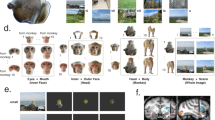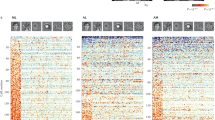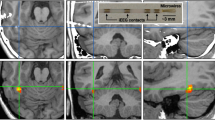Abstract
Visually guided eating, biting and kissing, and avoiding objects moving toward the face and toward which the face moves require prompt, coordinated processing of spatial visual and somatosensory information in order to protect the face and the brain. Single-cell recordings in parietal cortex have identified multisensory neurons with spatially restricted, aligned visual and somatosensory receptive fields, but so far, there has been no evidence for a topographic map in this area. Here we mapped the organization of a multisensory parietal face area in humans by acquiring functional magnetic resonance images while varying the polar angle of facial air puffs and close-up visual stimuli. We found aligned maps of tactile and near-face visual stimuli at the highest level of human association cortex—namely, in the superior part of the postcentral sulcus. We show that this area may code the location of visual stimuli with respect to the face, not with respect to the retina.
*NOTE: In the version of this article initially published online, there was an error in the affiliation in the html version. The first affiliation should read Department of Cognitive Science, University of California San Diego, La Jolla, California 92093, USA. The error has been corrected online.
This is a preview of subscription content, access via your institution
Access options
Subscribe to this journal
Receive 12 print issues and online access
$209.00 per year
only $17.42 per issue
Buy this article
- Purchase on Springer Link
- Instant access to full article PDF
Prices may be subject to local taxes which are calculated during checkout






Similar content being viewed by others
Change history
06 October 2006
Removed "Institute for Neural Computation"
References
Duhamel, J.R., Colby, C.L. & Goldberg, M.E. Ventral intraparietal area of the macaque: congruent visual and somatic response properties. J. Neurophys. 79, 126–136 (1998).
Colby, C.L., Duhamel, J.R. & Goldberg, M.E. Ventral intraparietal area of the macaque: anatomic location and visual response properties. J. Neurophys. 69, 902–914 (1993).
Bremmer, F., Duhamel, J.R., Ben Hamed, S. & Graf, W. Heading encoding in the macaque ventral intraparietal area (VIP). Eur. J. Neurosci. 16, 1554–1568 (2002).
Lewis, J.W. & Van Essen, D. Corticocortical connections of visual, sensorimotor, and multimodal processing areas in the parietal lobe of the macaque monkey. J. Comp. Neurol. 428, 112–137 (2000).
Cooke, D.F. & Graziano, M.S. Super-flinchers and nerves of steel: defensive movements altered by chemical manipulation of a cortical motor area. Neuron 43, 585–593 (2004).
Cooke, D.F., Taylor, C.S., Moore, T. & Graziano, M.S. Complex movements evoked by microstimulation of the ventral intraparietal area. Proc. Natl. Acad. Sci. USA 100, 6163–6168 (2003).
Bremmer, F. Navigation in space–the role of the macaque ventral intraparietal area. J. Physiol. (Lond.) 566, 29–35 (2005).
Grefkes, C. & Fink, G.R. The functional organization of the intraparietal sulcus in humans and monkeys. J. Anat. 207, 3–17 (2005).
Avillac, M., Deneve, S., Olivier, E., Pouget, A. & Duhamel, J.R. Reference frames for representing visual and tactile locations in parietal cortex. Nat. Neurosci. 8, 941–949 (2005).
Colby, C.L., Duhamel, J.R. & Goldberg, M.E. Visual, presaccadic, and cognitive activation of single neurons in monkey lateral intraparietal area. J. Neurophysiol. 76, 2841–2852 (1996).
Grunewald, A., Linden, J.F. & Andersen, R.A. Responses to auditory stimuli in macaque lateral intraparietal area. I. Effects of training. J. Neurophysiol. 82, 330–342 (1999).
Bremmer, F. et al. Polymodal motion processing in posterior parietal and premotor cortex: a human fMRI study strongly implies equivalencies between humans and monkeys. Neuron 29, 287–296 (2001).
Culham, J.C. & Kanwisher, N.G. Neuroimaging of cognitive functions in human parietal cortex. Curr. Opin. Neurobiol. 11, 157–163 (2001).
Sereno, M.I., Pitzalis, S. & Martinez, A.M. Mapping of contralateral space in retinotopic coordinates by a parietal cortical area in humans. Science 294, 1350–1354 (2001).
Merriam, E.P., Genovese, C.R. & Colby, C.L. Spatial updating in human parietal cortex. Neuron 39, 361–373 (2003).
Medendorp, W.P., Goltz, H.C., Vilis, T. & Crawford, J.D. Gaze-centered updating of visual space in human parietal cortex. J. Neurosci. 23, 6209–6214 (2003).
Sereno, M.I. et al. Borders of multiple visual areas in humans revealed by functional magnetic resonance imaging. Science 268, 889–893 (1995).
Pitzalis, S. et al. Wide-field retinotopy defines human cortical visual area V6. J. Neurosci. 26, 7962–7973 (2006).
Schluppeck, D., Glimcher, P. & Heeger, D.J. Topographic organization for delayed saccades in human posterior parietal cortex. J. Neurophysiol. 94, 1372–1384 (2005).
Hasson, U., Nir, Y., Levy, I., Fuhrmann, G. & Malach, R. Intersubject synchronization of cortical activity during natural vision. Science 303, 1634–1640 (2004).
Engel, S.A. et al. fMRI of human visual cortex. Nature 369, 525 (1994).
Fischl, B., Sereno, M.I., Tootell, R.B. & Dale, A.M. High-resolution intersubject averaging and a coordinate system for the cortical surface. Hum. Brain Mapp. 8, 272–284 (1999).
Hagler, D.J., Riecke, L. & Sereno, M.I. Pointing and saccades rely on common parietal and superior frontal visuospatial maps. Neuroimage (in the press).
Gattass, R. et al. Cortical visual areas in monkeys: location, topography, connections, columns, plasticity and cortical dynamics. Philos. Trans. R. Soc. Lond. B Biol. Sci. 360, 709–731 (2005).
Hagler, D.J. & Sereno, M.I. Spatial maps in frontal and prefrontal cortex. Neuroimage 29, 567–577 (2006).
Cook, E.P. & Maunsell, J.H. Attentional modulation of behavioral performance and neuronal responses in middle temporal and ventral intraparietal areas of macaque monkey. J. Neurosci. 22, 1994–2004 (2002).
Beauchamp, M. See me, hear me, touch me: multisensory integration in lateral occipital-temporal cortex. Curr. Opin. Neurobiol. 15, 145–153 (2005).
Calvert, G.A., Spence, C. & Stein, B.E. (eds.). Handbook of Multisensory Processing (MIT Press, Cambridge, Massachusetts, 2004).
Spence, C. & Driver, J. (eds.) Crossmodal Space and Crossmodal Attention (Oxford Univ. Press, Oxford, 2004).
Huang, R.-S., & Sereno, M.I. Dodecapus: an MR-compatible system for somatosensory stimulation. Neuroimage (in the press).
Sereno, M.I. & Tootell, R.B. From monkeys to humans: what do we now know about brain homologies? Curr. Opin. Neurobiol. 15, 135–144 (2005).
Collins, D.L., Neelin, P., Peters, T.M. & Evans, A.C. Automatic 3D intersubject registration of MR volumetric data in standardized Talairach space. J. Comput. Assist. Tomogr. 18, 192–205 (1994).
Culham, J.C. et al. Cortical fMRI activation produced by attentive tracking of moving targets. J. Neurophysiol. 80, 2657–2670 (1998).
Orban, G.A. et al. Similarities and differences in motion processing between the human and macaque brain: evidence from fMRI. Neuropsychologia 41, 1757–1768 (2003).
Tootell, R.B., Dale, A.M., Sereno, M.I. & Malach, R. New images from human visual cortex. Trends Neurosci. 19, 481–489 (1996).
Astafiev, S.V. et al. Functional organization of human intraparietal and frontal cortex for attending, looking, and pointing. J. Neurosci. 23, 4689–4699 (2003).
Mori, A. et al. Fifth somatosensory cortex (SV) representation of the whole body surface in the medial bank of the anterior suprasylvian sulcus of the cat. Neurosci. Res. 11, 198–208 (1991).
Monteiro, G.A., Clemo, H.R. & Meredith, M.A. Anterior ectosylvian cortical projections to the rostral suprasylvian multisensory zone in cat. Neuroreport 14, 2139–2145 (2003).
Thomas, H.C. & Espinoza, S.G. Relationships between interhemispheric cortical connections and visual areas in hooded rats. Brain Res. 417, 214–224 (1987).
Acknowledgements
We thank D. Hagler for developing the concept and software implementation of cross-subject averaging of complex-valued data on morphed surfaces; R. Buxton, E. Wong, T. Liu and L. Frank at the University of California San Diego fMRI Center for scan time, pulse sequences and advice; L. May and R. Kurz for technical assistance; A. Dale, S. Pitzalis, F. Dick and A. Chiba for help and discussions; and L. Kemmer for pilot experiments. Supported by National Science Foundation BCS 0224321 (M.I.S.); US National Institutes of Health R01 NS41925 (E.W.), R01 NS36722 (R.B.) and R01 HD041581 (J.S.); and the Swartz Foundation (T.-P.J.).
Author information
Authors and Affiliations
Contributions
The authors contributed equally to this work.
Corresponding author
Ethics declarations
Competing interests
The authors declare no competing financial interests.
Supplementary information
Supplementary Video 1
Face stimulus location and parietal face area activity map. The position of an air puff stimulus on the face is indicated by the moving white dot (center panel). The corresponding activity in the parietal face area is illustrated as a moving white stripe on closeup views of the unfolded cortex of the left and right hemisphere of one subject (left and right panels). The upper contralateral face (red) is represented anterior to the middle (blue) and lower (green) face in each hemisphere. (MPG 341 kb)
Rights and permissions
About this article
Cite this article
Sereno, M., Huang, RS. A human parietal face area contains aligned head-centered visual and tactile maps. Nat Neurosci 9, 1337–1343 (2006). https://doi.org/10.1038/nn1777
Received:
Accepted:
Published:
Issue Date:
DOI: https://doi.org/10.1038/nn1777
This article is cited by
-
Dynamic spatial coding in parietal cortex mediates tactile-motor transformation
Nature Communications (2023)
-
Variation in spatial dependencies across the cortical mantle discriminates the functional behaviour of primary and association cortex
Nature Communications (2023)
-
Emerging principles in functional representations of touch
Nature Reviews Psychology (2023)
-
The human middle temporal cortex responds to both active leg movements and egomotion-compatible visual motion
Brain Structure and Function (2022)
-
Egomotion-related visual areas respond to goal-directed movements
Brain Structure and Function (2022)



